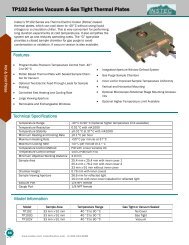Liquid Crystal Measurement Instruments 2007 - Instec Inc
Liquid Crystal Measurement Instruments 2007 - Instec Inc
Liquid Crystal Measurement Instruments 2007 - Instec Inc
Create successful ePaper yourself
Turn your PDF publications into a flip-book with our unique Google optimized e-Paper software.
<strong>Liquid</strong> <strong>Crystal</strong> Cells and Cell Holder<br />
<strong>Instec</strong> provides a lineup of empty liquid crystal test cells ideally suited for use with<br />
the ALCT in addition to other LC research applications. When measuring a liquid crystal’s<br />
parameters, sample preparation is as critical to the measurement as the testing<br />
instrument itself. <strong>Instec</strong>’s cells are manufactured with patterned electrodes in industry<br />
standard clean rooms and equipment. This yields a cell whose active sample area is<br />
known precisely, has low parasitic capacitance, and can be completely filled with the LC<br />
material under test.<br />
Even so, the reliance on spacers to determine cell gap can lead to errors of several<br />
percent. Thus for critical testing applications, <strong>Instec</strong> makes available calibrated cells<br />
whose spacing have been individually measured both optically and electronically. Each<br />
calibrated cell is then shipped along with its individual cell thickness and parasitic capacitance.<br />
The adhesive of <strong>Instec</strong> cells can withstand up to 200ºC. Alignment layers are of 1º to<br />
3º pre-tilt angles. Physical dimensions and spacing of cells vary depending on different<br />
models. Cell gap tolerance is ±0.2 µm.<br />
Image above is an example of<br />
LC1, 90° twist aligned.<br />
PI Type<br />
Homogenous Alignment<br />
90º Twist<br />
Homogenous Alignment<br />
Parallel<br />
Homogenous Alignment<br />
Anti-Parallel<br />
Homogenous Alignment<br />
Anti-Parallel<br />
Homeotropic Alignment<br />
Anti-Parallel<br />
Part No<br />
ITO Area<br />
(mm)<br />
Cell Spacing<br />
(microns)<br />
LC1-6.0<br />
6.0 µm<br />
5 X 5<br />
LC1-6.8 6.8 µm<br />
LC3-5.0<br />
5 µm<br />
LC2-5.0 5 µm<br />
LC4-6.8<br />
5 X 5<br />
6.8 µm<br />
LC2-9.0 9 µm<br />
LC2-20.0 20 µm<br />
SA025A04uG180 5 X 5 4 µm<br />
SA100A09uG180 10 X 10 9 µm<br />
SA100A18uG180 10 X 10 18 µm<br />
SA025A04uT180 5 X 5 4 µm<br />
SA100A09uT180 10 X 10 9 µm<br />
SA100A18uT180 10 X 10 18 µm<br />
No PI (Patterned ITO) SA100A04uNOPI 10 X 10 4 µm<br />
In-Plane-Switching<br />
Homogenous Alignment<br />
Vertical Rubbing to Electric<br />
Field<br />
In-Plane-Switching<br />
Homogenous Alignment<br />
Parallel Rubbing to Electric<br />
Field<br />
IPS02A09uGVE 10 X 10 9 µm<br />
IPS02A18uGVE 10 X 10 18 µm<br />
IPS02A09uGPE 10 X 10 9 µm<br />
IPS02A18uGPE 10 X 10 18 µm<br />
ITO<br />
Resistance<br />
Cell Outer Dimensions<br />
(mm) &<br />
Cell Holder Model<br />
100 Ω/□ 15.25 X 20.25 X 2.25<br />
100 Ω/□ 15.25 X 17 X 1.5<br />
30 Ω/□<br />
21 X 25 X 1.5<br />
Cell Holder: LCH2<br />
Image above shows the structures<br />
of LC2, LC3, and LC4 empty cells.<br />
Image above shows the structures<br />
of SA Series empty cells. Example<br />
is SA100<br />
LCH2<br />
<strong>Instec</strong> LC cell holder, LCH2 accommodate various <strong>Instec</strong> empty cell models: SA025,<br />
SA100, and IPS02. The cell holder can be used inside the <strong>Instec</strong> microscope hot and<br />
cold stages. The LCH2 has external electrical grounding for electrical noise shielding.<br />
The LCH2 can be used to attach electrodes to the LC Cells. Otherwise, solder or silver<br />
epoxy can be used to attach wires.<br />
How to Use <strong>Instec</strong> LC Cells<br />
There are two openings on <strong>Instec</strong> liquid crystal cells. Heat the cell above the isotropic temperature of your LC material.<br />
Then drop a very small amount of LC material on one opening of the <strong>Instec</strong> empty cell. The capillary force will suck LC<br />
material into the empty cell. It may take a few minutes before the cell is fully filled. You can see the filling process at<br />
"right" angle under light. Once the cell is filled, in order to get good alignment, please cool down slowly, especially during<br />
the phase transition temperature.<br />
9



